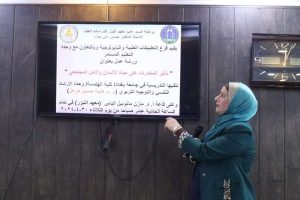1- Urging the teachers to obtain the Hirsch coefficient ( h-index ) for Google Scholar and Scopus containers and to register in the Research Gate according to the university’s instructions.
2- Urging all faculty and students at the Institute to publish in reputable international journals within the containers of Thomson Reuters and Scopus and international publishing houses such as Elsevier and Springer, which have an impact factor IF especially, since publishing in these journals has become one of the requirements for scientific promotions to the rank of Professor and Assistant Professor and entered the discussion evaluation form for postgraduate students. In addition, it contributes to raising the world ranking of our university.
3- Optimizing the use of equipment obtained through pilot projects for developing laboratories at the institute and implementing projects for doctoral, masters and higher diploma students.
4- Holding seminars and workshops related to global scientific trends related to laser applications in engineering and medical sciences to increase knowledge of the latest developments in these fields and hosting external lecturers from universities or state departments related to the subject.
5- Attention to the topic of delivering a seminar number (2) by the teaching staff and according to the directive of the University of Baghdad (the study and research presentation), in addition to holding seminars every six months for graduate students in the master’s and doctoral stages to determine the extent of progress in the projects of graduate students in the research stage, in order to follow up their progress in their research project and to stop at the obstacles they face in their research, whether in terms of the need for scientific consultations or the provision of equipment or sometimes a change in the research plan if necessary.
6- The research trends at the institute for the previous year and the current year are pushing towards nano-photonics, as most of the laser applications in pure sciences, advanced engineering, and medical sciences stem from the subject of nano-photonics, such as bio-photonics and fiber optic lasers, and the research line in quantum optics applications in cryptography quantitative. In addition to the advanced research line in the field of laser material processing , photonic sensors, semi-materials and applications of plasmonics in optical fiber communications, photonic device manufacturing, biochemistry, and laser and plasma interaction.
7- Urging the teaching staff who have obtained the current scientific title for more than five years to submit the promotion treatment to obtain the subsequent scientific title.
8- Encouraging the teaching staff to apply for the research staff development program and to apply for full-time studies in reputable universities.
9- Awareness of teachers of the need for doctoral, master’s and diploma research to be directed to serving and solving real problems in the country and cooperating with the relevant state ministries, as possible. And the Institute’s plan is to activate joint cooperation with the Ministry of Communications.
10 – Follow up the labor market for graduates of the Institute for the previous years and communicate with them and hold annual meetings by arranging workshops to find out their experiences gained from work or study.


